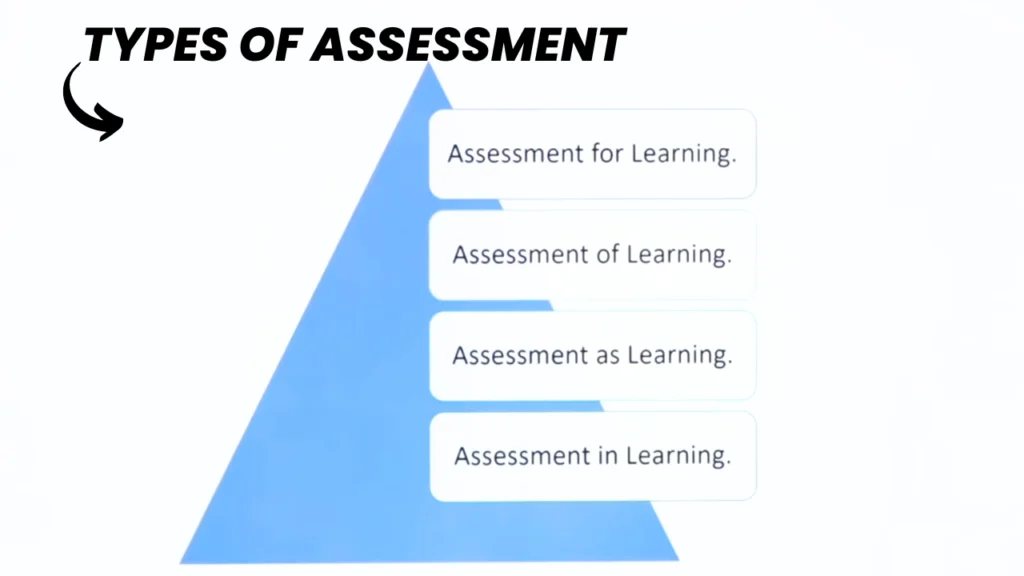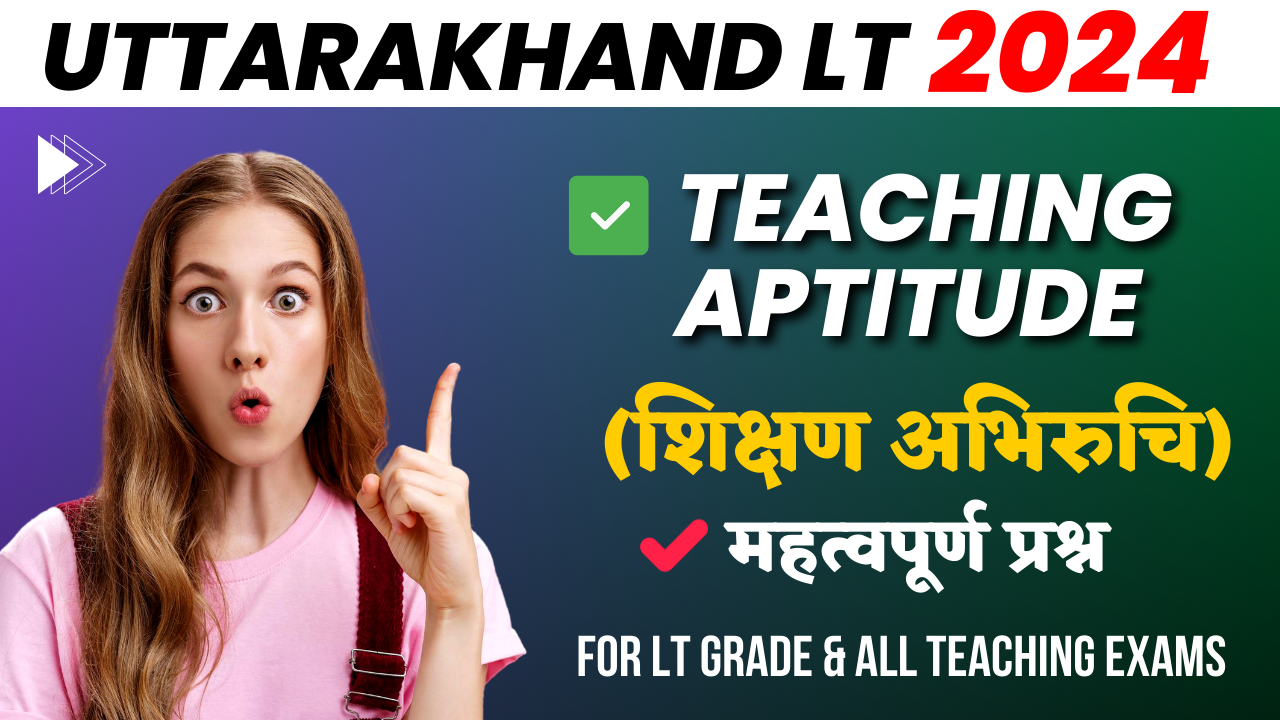Uttarakhand LT Teaching Aptitude MCQ : उत्तराखंड में LT Exam की तैयारी कर रहे विद्यार्थियों के लिए उत्तराखंड आयोग (UKSSSC) बहुत ही जल्दी उत्तराखंड में LT Grade 2024 की परीक्षा आयोजित करने जा रहा है, जो भी अभ्यर्थी उत्तराखंड में लेक्चर ग्रेड में आवेदन करने योग्य है और आवेदन करना चाहते हैं ,उनके लिए यह सुनहरा अवसर है । आयोग (UKSSSC) बहुत ही जल्दी ऑफिशल वेबसाइट पर नोटिफिकेशन जारी करने वाला है ।
इस परीक्षा की तैयारी के लिए शिक्षण अभिरुचि (Teaching Aptitude) बहुत ही महत्वपूर्ण है । इस आर्टिकल में हम आपके लिए (Teaching Aptitude) के महत्वपूर्ण प्रश्नों को लेकर आए हैं । इन प्रश्नों की सहायता से आप परीक्षा में पूछे जाने वाले 30 अंक के शिक्षण अभिरुचि (Teaching Aptitude MCQ) से संबंधित प्रश्नों की तैयारी कर सकते हैं । परीक्षा की तैयारी को मजबूत करने के लिए एक बार इन प्रश्नों को जरूर पढ़ें ।
Teaching Aptitude MCQ for Uttarakhand LT Exam 2024 | Uttarakhand LT Exam Syllabus | LT Exam Pattern
Your Queries
- Uttarakhand LT Exam 2024
- Teaching Aptitude MCQ in Hindi
- Uttarakhand LT Exam Teaching Aptitude Questions
- Teaching Aptitude For Uttarakhand LT Exam
- UKSSSC LT Exam Pattern
- Teaching Aptitude MCQ for Uttarakhand LT Exam
Q1:Bloom’s Taxonomy categorizes learning objectives into different levels. Which of the following is the correct sequence of these levels from the simplest to the most complex?
a) Remembering, Understanding, Applying, Analyzing, Evaluating, Creating
b) Understanding, Remembering, Applying, Analyzing, Creating, Evaluating
c) Remembering, Understanding, Applying, Evaluating, Analyzing, Creating
d) Understanding, Remembering, Applying, Creating, Analyzing, Evaluating
Ans: a) Remembering, Understanding, Applying, Analyzing, Evaluating, Creating
Q: ब्लूम का वर्गीकरण सीखने के उद्देश्यों को विभिन्न स्तरों में वर्गीकृत करता है। सरलतम से सर्वाधिक जटिल तक इन स्तरों का सही क्रम निम्नलिखित में से कौन सा है?
A) याद रखना, समझना, लागू करना, विश्लेषण करना, मूल्यांकन करना, बनाना
B) समझना, याद रखना, लागू करना, विश्लेषण करना, बनाना, मूल्यांकन करना
C) याद रखना, समझना, लागू करना, मूल्यांकन करना, विश्लेषण करना, बनाना
D) समझना, याद रखना, लागू करना, बनाना, विश्लेषण करना, मूल्यांकन करना
उत्तर: A) याद रखना, समझना, लागू करना, विश्लेषण करना, मूल्यांकन करना, बनाना
Q2: When designing assessments, which of the following principles is crucial to ensure fairness and validity?
a) Standardization
b) Subjectivity
c) Exclusivity
d) Ambiguity
Ans: a) Standardization
Q2: मूल्यांकन डिजाइन करते समय, निष्पक्षता और वैधता सुनिश्चित करने के लिए निम्नलिखित में से कौन सा सिद्धांत महत्वपूर्ण है?
A) मानकीकरण
B) विषयपरकता
C) विशिष्टता
D) अस्पष्टता
उत्तर: A) मानकीकरण
Q3: Which teaching method is most suitable for encouraging active student participation and engagement in the learning process?
a) Lecture
b) Demonstration
c) Discussion
d) Drill and practice
Ans: c) Discussion
Q3: सीखने की प्रक्रिया में छात्रों की सक्रिय भागीदारी और सहभागिता को प्रोत्साहित करने के लिए कौन सी शिक्षण पद्धति सबसे उपयुक्त है?
A) व्याख्यान
B) प्रदर्शन
C) चर्चा
D) ड्रिल और अभ्यास करें
उत्तर: C) चर्चा
Q4: In the context of educational psychology, what does the term “scaffolding” refer to?
a) Providing support and guidance to learners as they develop new skills or knowledge
b) Punishing students for their mistakes to encourage better performance
c) Allowing students to work independently without any assistance
d) Restricting access to resources to challenge students
Ans: a) Providing support and guidance to learners as they develop new skills or knowledge
Q4: शैक्षिक मनोविज्ञान के संदर्भ में, “मचान” शब्द का तात्पर्य क्या है?
A) शिक्षार्थियों को सहायता और मार्गदर्शन प्रदान करना क्योंकि वे नए कौशल या ज्ञान विकसित करते हैं
B) बेहतर प्रदर्शन को प्रोत्साहित करने के लिए छात्रों को उनकी गलतियों के लिए दंडित करना
C) छात्रों को बिना किसी सहायता के स्वतंत्र रूप से काम करने की अनुमति देना
D) छात्रों को चुनौती देने के लिए संसाधनों तक पहुंच को प्रतिबंधित करना
उत्तर: A) शिक्षार्थियों को सहायता और मार्गदर्शन प्रदान करना क्योंकि वे नए कौशल या ज्ञान विकसित करते हैं
Q5.Which learning theory emphasizes the importance of observation and modeling in the learning process?
a) Behaviorism
b) Constructivism
c) Humanism
d) Social learning theory
Ans: d) Social learning theory
Q5.कौन सा शिक्षण सिद्धांत सीखने की प्रक्रिया में अवलोकन और मॉडलिंग के महत्व पर जोर देता है?
A) व्यवहारवाद
B) रचनावाद
C) मानवतावाद
D) सामाजिक शिक्षण सिद्धांत
उत्तर: D) सामाजिक शिक्षण सिद्धांत
Q6. What is the primary purpose of formative assessment?
a) To evaluate student learning at the end of a course
b) To provide feedback to both teachers and students during the learning process
c) To rank students based on their performance
d) To assess students’ mastery of a subject area
Ans: b) To provide feedback to both teachers and students during the learning process
Q6. रचनात्मक मूल्यांकन का प्राथमिक उद्देश्य क्या है?
A) पाठ्यक्रम के अंत में छात्रों के सीखने का मूल्यांकन करना
B) सीखने की प्रक्रिया के दौरान शिक्षकों और छात्रों दोनों को फीडबैक प्रदान करना
C) छात्रों को उनके प्रदर्शन के आधार पर रैंक देना
D) किसी विषय क्षेत्र में छात्रों की महारत का आकलन करना
उत्तर: B) सीखने की प्रक्रिया के दौरान शिक्षकों और छात्रों दोनों को फीडबैक प्रदान करना

Q7. Which of the following is NOT a factor that influences classroom management?
a) Teacher-student relationships
b) Classroom layout
c) Curriculum design
d) Teaching style
Ans: c) Curriculum design
Q7. निम्नलिखित में से कौन सा वह कारक नहीं है जो कक्षा प्रबंधन को प्रभावित करता है?
A) शिक्षक-छात्र संबंध
B) कक्षा लेआउट
C) पाठ्यचर्या डिजाइन
D) शिक्षण शैली
उत्तर: C) पाठ्यचर्या डिजाइन
Q8. What is the term used to describe the process of modifying instruction to meet the needs of diverse learners?
a) Differentiation
b) Standardization
c) Homogenization
d) Segregation
Ans: a) Differentiation
Q8. विविध शिक्षार्थियों की आवश्यकताओं को पूरा करने के लिए निर्देश को संशोधित करने की प्रक्रिया का वर्णन करने के लिए किस शब्द का उपयोग किया जाता है?
A) भेदभाव
B) मानकीकरण
C) समरूपीकरण
D) पृथक्करण
उत्तर: A) भेदभाव
Q9. Which of the following teaching strategies is most effective for promoting critical thinking skills?
a) Rote memorization
b) Problem-based learning
c) Direct instruction
d) Passive listening
Ans: b) Problem-based learning
Q9. आलोचनात्मक सोच कौशल को बढ़ावा देने के लिए निम्नलिखित में से कौन सी शिक्षण रणनीति सबसे प्रभावी है?
A) रटकर याद करना
B) समस्या-आधारित शिक्षा
C) सीधा निर्देश
D) निष्क्रिय श्रवण
उत्तर: B) समस्या-आधारित शिक्षा
Q10. What is the term used to describe the process of breaking down complex skills or concepts into smaller, more manageable parts?
a) Chunking
b) Segregation
c) Integration
d) Standardization
Ans: a) Chunking
Q10. जटिल कौशल या अवधारणाओं को छोटे, अधिक प्रबंधनीय भागों में तोड़ने की प्रक्रिया का वर्णन करने के लिए किस शब्द का उपयोग किया जाता है?
A) चंकिंग
B) पृथक्करण
C) एकीकरण
D) मानकीकरण
उत्तर: A) चंकिंग
Q11. Which of the following is an example of a formative assessment?
a) Final exam
b) Midterm paper
c) Classroom discussion
d) Standardized test
Ans: c) Classroom discussion
प्रश्न11. निम्नलिखित में से कौन सा रचनात्मक मूल्यांकन का उदाहरण है?
A) अंतिम परीक्षा
B) मध्यावधि पेपर
C) कक्षा चर्चा
D) मानकीकृत परीक्षण
उत्तर: C) कक्षा चर्चा
Q12. Which educational theorist is known for his theory of multiple intelligences, suggesting that intelligence is not a single, fixed trait but rather a combination of various modalities?
a) B.F. Skinner
b) Jean Piaget
c) Lev Vygotsky
d) Howard Gardner
Ans: d) Howard Gardner
प्रश्न12. किस शैक्षिक सिद्धांतकार को बहु-बुद्धि के अपने सिद्धांत के लिए जाना जाता है, जो सुझाव देता है कि बुद्धिमत्ता एक एकल, निश्चित गुण नहीं है, बल्कि विभिन्न तौर-तरीकों का एक संयोजन है?
A) बी.एफ. स्किनर
B) जीन पियागेट
C) लेव वायगोत्स्की
D) हावर्ड गार्डनर
उत्तर: D) हावर्ड गार्डनर
Q13. Which teaching method emphasizes hands-on learning experiences where students engage in real-world tasks and solve authentic problems?
a) Expository teaching
b) Inquiry-based learning
c) Direct instruction
d) Drill and practice
Ans: b) Inquiry-based learning
Q13. कौन सी शिक्षण पद्धति व्यावहारिक सीखने के अनुभवों पर जोर देती है जहां छात्र वास्तविक दुनिया के कार्यों में संलग्न होते हैं और प्रामाणिक समस्याओं का समाधान करते हैं?
A) व्याख्यात्मक शिक्षण
B) पूछताछ-आधारित शिक्षा
C) सीधा निर्देश
D) ड्रिल और अभ्यास करें
उत्तर: B) पूछताछ-आधारित शिक्षा
Q14. In the context of educational assessment, what does the acronym “RUBRIC” stand for?
a) Rating of Underlying Behaviors in Classroom Instruction
b) Regular Utilization of Broad Range of Instructional Criteria
c) Reliable Understanding of Broad Range of Instructional Concepts
d) Reliable Use of Balanced Rubric for Instructional Criteria
Ans: d) Reliable Use of Balanced Rubric for Instructional Criteria
प्रश्न14. शैक्षिक मूल्यांकन के संदर्भ में, “RUBRIC” का संक्षिप्त रूप क्या है?
A) कक्षा निर्देश में अंतर्निहित व्यवहार की रेटिंग
B) अनुदेशात्मक मानदंडों की विस्तृत श्रृंखला का नियमित उपयोग
C) अनुदेशात्मक अवधारणाओं की विस्तृत श्रृंखला की विश्वसनीय समझ
D) निर्देशात्मक मानदंड के लिए संतुलित रूब्रिक का विश्वसनीय उपयोग
उत्तर: D) निर्देशात्मक मानदंड के लिए संतुलित रूब्रिक का विश्वसनीय उपयोग
Q15. Which of the following is an example of a summative assessment?
a) Weekly quizzes
b) Final project
c) Classroom observation
d) Peer evaluation
Ans: b) Final project
प्रश्न 15. निम्नलिखित में से कौन सा योगात्मक मूल्यांकन का उदाहरण है?
A) साप्ताहिक प्रश्नोत्तरी
B) अंतिम परियोजना
C) कक्षा अवलोकन
D) सहकर्मी मूल्यांकन
उत्तर: B) अंतिम परियोजना
Q16. Which instructional strategy involves presenting information in small, incremental steps and frequently checking for student understanding before moving on to the next concept?
a) Mastery learning
b) Project-based learning
c) Flipped classroom
d) Differentiated instruction
Ans: a) Mastery learning
Q16. किस अनुदेशात्मक रणनीति में जानकारी को छोटे, वृद्धिशील चरणों में प्रस्तुत करना और अगली अवधारणा पर आगे बढ़ने से पहले छात्र की समझ की बार-बार जाँच करना शामिल है?
A) सीखने में महारत हासिल करना
B) परियोजना-आधारित शिक्षा
C) पलटी हुई कक्षा
D) विभेदित निर्देश
उत्तर: A) सीखने में निपुणता
Q17. Which educational theorist is associated with the concept of the zone of proximal development (ZPD), which refers to the difference between what a learner can do without assistance and what they can achieve with guidance and support?
a) B.F. Skinner
b) Jean Piaget
c) Lev Vygotsky
d) Erik Erikson
Ans: c) Lev Vygotsky
Q17. कौन सा शैक्षिक सिद्धांतकार समीपस्थ विकास क्षेत्र (जेडपीडी) की अवधारणा से जुड़ा है, जो एक शिक्षार्थी सहायता के बिना क्या कर सकता है और मार्गदर्शन और समर्थन के साथ क्या हासिल कर सकता है, के बीच अंतर को संदर्भित करता है?
A) बी.एफ. स्किनर
B) जीन पियागेट
C) लेव वायगोत्स्की
D) एरिक एरिकसन
उत्तर: C) लेव वायगोत्स्की
Q18. Which of the following is NOT a principle of Universal Design for Learning (UDL)?
a) Multiple means of representation
b) Multiple means of assessment
c) Multiple means of engagement
d) Single means of instruction
Ans: d) Single means of instruction
प्रश्न18. निम्नलिखित में से कौन सा यूनिवर्सल डिज़ाइन फॉर लर्निंग (यूडीएल) का सिद्धांत नहीं है?
A) प्रतिनिधित्व के अनेक साधन
B) मूल्यांकन के अनेक साधन
C) सहभागिता के अनेक साधन
D) शिक्षा का एकल साधन
उत्तर: D) शिक्षा का एकल साधन
Q19. Which of the following instructional technologies allows for synchronous communication and collaboration among learners and instructors in real-time?
a) Email
b) Discussion forums
c) Video conferencing
d) Blogs
Ans: c) Video conferencing
प्रश्न19. निम्नलिखित में से कौन सी अनुदेशात्मक तकनीक वास्तविक समय में शिक्षार्थियों और प्रशिक्षकों के बीच समकालिक संचार और सहयोग की अनुमति देती है?
A) ईमेल
B) चर्चा मंच
C) वीडियो कॉन्फ्रेंसिंग
D) ब्लॉग
उत्तर: C) वीडियो कॉन्फ्रेंसिंग
Read More:
